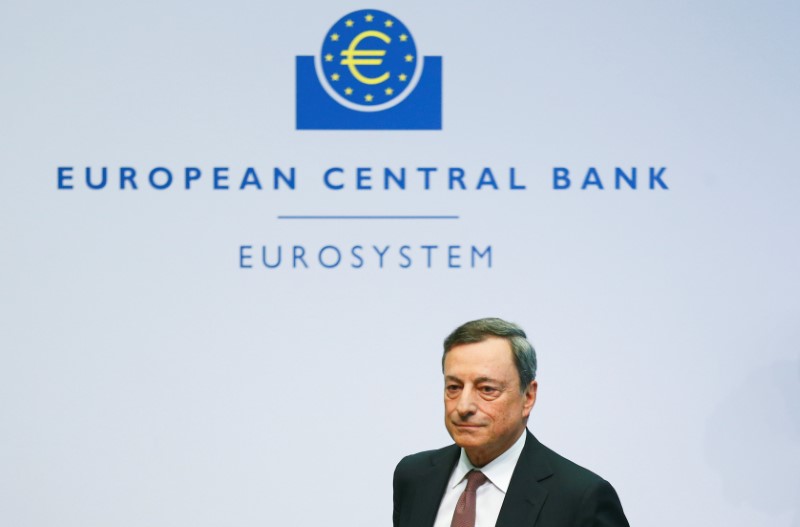By Helen Reid and Abhinav Ramnarayan
LONDON (Reuters) - Focus has sharpened on how exchange-traded bond funds react to market shocks after recent wobbles showed some performing out of line with the assets they are designed to mirror.
Although bond ETFs largely behaved as expected, some didn't when European Central Bank chief Mario Draghi triggered a bond sell off by hinting the ECB's bond-buying stimulus scheme may soon be scaled back.
Such market dislocations are making investors more selective and wary of these increasingly popular products.
Investors pumped around $81 billion into bond ETFs in the first six months of 2017 -- up 19 percent from the same period in 2016, according to ETF data provider ETFGI.
As the volume of ETFs has grown, some investors have raised concerns that although the ETFs themselves are highly liquid, the underlying assets may be less so, especially under the strain of a major market fall.
ETFs trade like stocks but track a wider range of securities more cheaply than buying the underlying assets. In this case, so-called physically-replicated bond ETFs track a basket of bonds which resembles, in duration and creditworthiness, a wider underlying index.
The recent sell-off, driven by Draghi's comments in Sintra, Portugal, exposed divergences in how closely the ETFs replicate their index.
"You will see the funds that do better, those that are moving within averages and those that are not, when there comes a big spread event or a big move in treasury yields," said Antoine Lesne, head of ETF strategy and research for EMEA at SPDR, State Street Global Advisors' ETF arm.
Two major European ETF providers said the tracking difference -- the gap between the performance of a tracker and its underlying index of bonds -- remained stable for most of their products.
Deutsche Asset Management's European government bond ETFs and high yield corporate bond ETFs stuck close to their indexes during the sell-off while bid-ask spreads -- which would widen if underlying liquidity was under strain -- remained near their average, data showed.
But some products did not track their index as closely during the sell-off.
"On a day like Sintra, you could see some funds that were not working the way they were supposed to be working," said Lesne, adding SPDR products remained close to their indexes.
Corporate events also have revealed some ETFs do not do what would be expected.
The tracking difference for one high-yield corporate debt ETF blew out to 8 basis points when the ECB rescued Spain's troubled Banco Popular, sending the bank's subordinated bonds plummeting.
This indicated the ETF provider had taken an active decision to avoid Banco Popular bonds, causing an outperformance compared with the underlying iBoxx Markit high-yield corporate debt index, which includes them.
"Taking an active stance like that may go in your favor, or it may go against you," Lesne said.
The premium or discount at which an ETF trades to its net asset value can also widen significantly in times of heightened buying or selling pressure, data shows.
Premia on ETFs tracking high-yield corporate debt shot up when the ECB said in March 2016 it would buy corporate debt under its stimulus program, and fell significantly around the Brexit vote and the U.S. presidential election later that year.
LIQUIDITY CONCERNS
Worries over low liquidity have grown as ETFs in relatively illiquid areas, like emerging markets debt and high-yield corporates, have seen some of the biggest inflows this year.
"Investors are concerned about the strong inflows into emerging market ETFs and the potential forced selling should the risk-on environment reverse," Morgan Stanley (NYSE:MS) analysts said in a note.
Flows into emerging market debt ETFs accelerated to $3.2 billion in June, bringing the year-to-date total to $13.6 billion, already exceeding 2016’s full-year record, according to iShares, Blackrock's ETF business.
"In the more exotic, niche strategies, if the ETF needs to sell it's not very clear there would be someone on the other side of the market to bid for the bonds," said Vincent Deluard, head of global macro strategy at INTL FCStone.
But providers say the relatively small size of ETFs compared with the total market in these assets limits the impact a downturn could have.
"The markets are so huge that no ETF is so big it could create an issue," said Michael Mohr, head of fixed income product development at Deutsche Asset Management.
"Emerging market bonds are less liquid, but if you compare the assets under management in ETFs to the total assets in that market, the ratio is still very small," he added.
Providers are also seeing less demand than they expected for some of their niche emerging market products, indicating there may be a limit to how far investors want bond ETFs to go.
In February, Deutsche Bank (DE:DBKGn) liquidated one ETF tracking Indonesian bonds and one Korean bonds, Lipper data shows.
